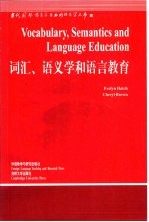

词汇、语义学和语言教育 英文版PDF电子书下载
- 电子书积分:15 积分如何计算积分?
- 作 者:(英)EvelynHatch,(英)CherylBrown著王初明导读
- 出 版 社:北京:外语教学与研究出版社
- 出版年份:2001
- ISBN:7560024289
- 页数:477 页
Introduction 1
Preface by Haliday F 11
王宗炎序 F 12
Part 1 Semantics 13
1 Semantic features and semantic feature analysis 14
Features 14
Preface by Chomsky F 15
Features in synonyms and antonyms 19
沈家煊序 F 22
Features in definitions 23
Semantic features and grammar 24
导读 F 25
Evaluation of semantic feature analysis 28
Research and application 31
Preface F 33
2 Semantic field analysis 33
Semantic fields 33
Acknowledgments F 35
Semantic field displays 37
Evaluation of semantic field analysis 41
Research and application 44
Core meanings 47
3 Core meanings and prototype theory 47
Prototypes 52
Fuzzy categories,levels,and prototypes 58
Research and application 61
4 Relational models in semantics 64
Types of relations 65
Relational models 71
Relational models in dictionaries 75
Applying relational models 77
Research and application 83
Pervasiveness of figurative language 86
5 Semantics of figurative language 86
Categorizing figurative language 88
Metaphor as a universal process 92
Acquisition of metaphor 99
Literary and conceptual metaphor 102
Social models and metaphor 105
Metaphors of teaching and learning 107
Research and application 112
6 Semantic space across languages 115
Universal categories 116
Acquisition and error analysis 124
Error analysis,loan translation,and cognates 127
Predicting difficulty 131
Research and application 138
Scripts 145
7 Script semantics and conceptual structure 145
Scripts and semantics 151
Script semantics,language teaching,and testing 156
Thematic and conceptual structure theory 158
Summary of Part I 163
Research and application 164
Part Ⅱ Lexicon 169
8 Adding to the lexicon 170
Borrowing 170
Coinage 175
Names of people and places 176
Conversion 179
Shifts 181
Research and application 185
Compounding 189
9 Processes in word building 189
Acquisition of compounds 193
Reduplication 196
Phrasal lexicon 199
Idioms and proverbs 202
How large can a lexical unit be? 206
Clipping 208
Initialization and acronyms 210
Blends 211
Research and application 213
Part Ⅲ Lexical cases and morphology 217
10 Word classification 218
Nouns 219
Verbs 222
Adjectives 228
Adverbs 230
Pronouns 234
Conjunctions 238
Prepositions 243
Articles and demonstratives 247
Research and application 254
11 Morphology and derivations 261
Identifying morphemes 261
Classifying morphemes 264
Derivations 268
Derivational prefixes 271
Derivational suffixes 275
Other derivational processes 279
Research and application 281
12 Inflectional morphology 285
Inflections 285
Morpheme acquisition studies 288
Errors in inflections and derivations 294
Morphophonemic change 296
Research and application 298
Part Ⅳ Vocabulary choice and discourse use 301
13 Variation in vocabulary choice 302
Geography 302
Gender 307
Age 309
Occupation 312
Education 314
Group and individual choices 316
Formality 319
Research and application 325
14 The vocabulary of communication signals and speech acts 328
Communication signals 328
The lexicon of speech acts and speech events 348
Research and application 363
Part Ⅴ Vocabulary learning and vocabulary teaching 367
15 General vocabulary learning and learner strategies 368
General issues 368
Five essential steps in vocabulary learning 372
Learner compensation strategies 392
Research and application 397
16 Vocabulary pedagogy and teacher strategies 401
Unplanned vocabulary adjustments and teaching 401
Planned vocabulary adjustments and teaching 405
Research and application 423
Conclusion 426
References 427
文库索引 449
Index 457
- 《培智学校义务教育实验教科书教师教学用书 生活适应 二年级 上》人民教育出版社,课程教材研究所,特殊教育课程教材研究中心编著 2019
- 《习近平总书记教育重要论述讲义》本书编写组 2020
- 《办好人民满意的教育 全国教育满意度调查报告》(中国)中国教育科学研究院 2019
- 《卓有成效的管理者 中英文双语版》(美)彼得·德鲁克许是祥译;那国毅审校 2019
- 《教育学考研应试宝典》徐影主编 2019
- 《语文教育教学实践探索》陈德收 2018
- 《家庭音乐素养教育》刘畅 2018
- 《学前教育学》王换成主编 2019
- 《近代体育游戏教育史料汇编 第1辑 1》王强主编 2016
- 《全国学前教育专业(新课程标准)“十三五”规划教材 简谱手风琴教程 第2版》(中国)杨克勤,王宝庆 2019
- 《古代巴比伦》(英)莱昂纳德·W.金著 2019
- 《BBC人体如何工作》(英)爱丽丝.罗伯茨 2019
- 《一个数学家的辩白》(英)哈代(G.H.Hardy)著;李文林,戴宗铎,高嵘译 2019
- 《莎士比亚全集 2》(英)莎士比亚著,朱生豪等译 2002
- 《莎士比亚戏剧精选集》(英)威廉·莎士比亚(William Shakespeare)著 2020
- 《莎士比亚 叙事诗·抒情诗·戏剧》(英)威廉·莎士比亚著 2019
- 《亚历山大继业者战争 上 将领与战役》(英)鲍勃·本尼特,(英)麦克·罗伯茨著;张晓媛译 2019
- 《孩子们的音乐之旅 1 宝宝睡觉 幼儿版》包菊英主编 2016
- 《超级参与者》王金强责编;赵磊译者;(澳)杰里米·海曼斯,(英)亨利·蒂姆斯 2020
- 《物联网导论》张翼英主编 2020
